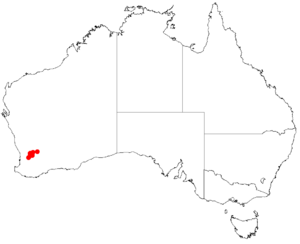Column hakea facts for kids
Quick facts for kids Column hakea |
|
|---|---|
| Conservation status | |
| Scientific classification | |
| Genus: |
Hakea
|
| Species: |
aculeata
|
 |
|
| Occurrence data from Australasian Virtual Herbarium | |
The Column Hakea, known scientifically as Hakea aculeata, is a special plant. It belongs to the Proteaceae family. You can find this unique shrub in the Wheatbelt area of Western Australia. It's called "column hakea" because it grows in tall, dense columns. This plant has very prickly leaves and lots of sweet-smelling flowers in spring. Sadly, it is a vulnerable species, meaning it needs protection.
Contents
What Does Column Hakea Look Like?
The Column Hakea is a shrub that can grow up to 3 m (10 ft) tall. It has many stems that grow straight up, forming a column shape. Its smaller branches are covered in soft, fine hairs.
Leaves and Flowers
The leaves of the Column Hakea are very prickly. They can be 12–50 mm (0.5–2 in) long and 3–9 mm (0.1–0.4 in) wide. They grow in a spiral pattern around the stem. Each leaf is hairy and has a sharp point at its tip.
In spring, this plant produces many beautiful flowers. They are usually cream, yellow, and red. These flowers grow in clusters where the leaves meet the stem on the upper branches. The small stalks holding the flowers are smooth. After the flowers, the plant grows smooth fruits. These fruits are 13–20 mm (0.5–0.8 in) long and 11–14 mm (0.4–0.6 in) wide. They have a short, pointed tip.
How Column Hakea Got Its Name
The Column Hakea was first officially described in 1979. A scientist named Alex George found a sample of the plant near Cunderdin. He then wrote about it in a science journal called Nuytsia.
Meaning of the Name
The second part of its scientific name, aculeata, comes from a Latin word. "Aculeatus" means "prickly" or "sharp-pointed". This name perfectly describes the plant's very prickly leaves!
Where Column Hakea Lives
The Column Hakea is a rare plant. It grows in the southwestern part of Western Australia. You can find it in areas like Brookton, Cunderdin, Merredin, Tammin, and Quairading.
Its Home Environment
This plant prefers to grow in sandy soil mixed with clay. It thrives in open areas with lots of sunlight. It also needs soil that drains water well. The Column Hakea is quite tough. It can handle both frost and dry periods.
Protecting the Column Hakea
The Column Hakea is considered a "Threatened Flora" by the Western Australian Government. This means it is a very important plant that needs special protection. It is an endangered species. Scientists know of only about 19 groups of these plants left in the wild. Efforts are being made to help this unique plant survive and thrive.


